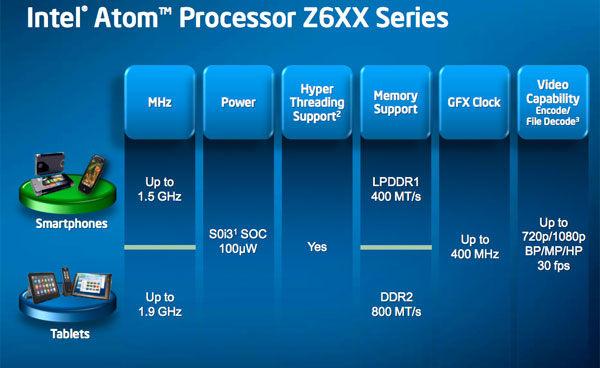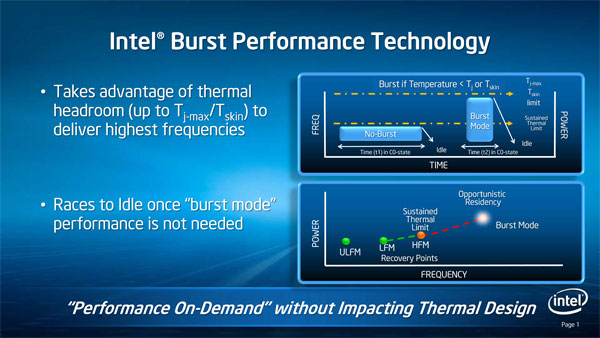Intel Unveils Moorestown and the Atom Z600, The Fastest Smartphone Platform?
by Anand Lal Shimpi on May 4, 2010 11:54 PM EST- Posted in
- Smartphones
- Intel
- Atom
- Mobile
- SoCs
Clock Speeds: 1.2GHz - 1.5GHz for Smartphones, 1.9GHz for Tablets
Intel isn't announcing individual Atom Z600 SKUs just yet, but we do know that all versions of the chip will support Hyper Threading (likely due to maintain a performance advantage compared to upcoming dual-core ARM offerings). There will be two versions of the Atom Z600 chips, one for smartphones and one for tablets.

The smartphone SKUs will run between 1.2GHz and 1.5GHz, while the tablet version of the Z600 will run at up to 1.9GHz.
Power Management: Clock Down or Turbo Up
Eleven years ago Intel demoed a technology it called Geyserville for mobile CPUs. The technology simply ran the CPU at a lower frequency when running on battery power and a higher frequency when plugged in. Intel eventually called this SpeedStep.
Four years later we got EIST, Enhanced Intel SpeedStep Technology. This allowed a mobile (and eventually desktop) CPU to run at any frequency depending on the performance demanded by the OS and the running applications.
On today’s Atom processors this usually means the chip will run as low as 600MHz when idle and at 133MHz increments all the way up to 1.66GHz under load. You don’t normally drop below 600MHz because that falls into the inefficient range of CPU performance scaling for a netbook/nettop. In a smartphone though, the majority of time your CPU isn’t being used. The SoC and accessory processors have enough custom logic offload a lot, even when your phone isn’t idle.
Lincroft, or the Atom Z600 series, supports even lower frequency modes. The CPU can clock itself down well below 600MHz.
When you need performance however Lincroft has something similar to Turbo Boost on Intel’s desktop CPUs. On the Atom Z600 series it’s called Burst Mode and unlike Turbo, it is more tightly integrated with the OS.

EIST and other dynamic clocking technologies rely on OS P-states to determine what frequency the chip should run at. If an OS requests P0, the CPU simply runs at its highest frequency.
On the Core i5 and i7, if the OS requests the CPU be in P0, then as long as the chip doesn’t violate any current or TDP limitations it will run at a higher turbo frequency instead of the default maximum clock speed the OS is requesting. P0 will always return the highest possible frequency given the thermal conditions of the chip.
The Atom Z600 doesn’t work like this. All potential burst mode frequencies are enumerated as P-states by the BIOS. An OS with proper support for Moorestown will be able to request any specific clock frequency, even burst frequencies. Loading a web page for example might result in the OS asking for the highest possible burst mode frequency, but while you’re reading the page the OS might request a slower P-state. The chip will run at whatever the OS requests, but it will exit burst mode if the chip’s temperature gets too high.
The FSB speed also scales with clock frequency. Once you reach a certain clock speed threshold, the Atom Z600 will automatically double its FSB frequency to help feed the CPU faster. The goal isn’t just to deliver peak performance, but it’s also to complete tasks faster so that the SoC can return to an idle state as soon as possible. The hurry up and go idle approach to mobile CPU performance has been one of Intel’s basic tenants for well over a decade now. And it does work. This is the reason we’ve generally seen an increase in battery life from each subsequent version of the Centrino platform.
The software management of burst mode puts more emphasis on the OS and platform vendors to properly tune their devices for the best balance of performance/power consumption. You can see why Wind River’s Android platform and Moblin are necessary to get the most out of Moorestown.










67 Comments
View All Comments
strikeback03 - Wednesday, May 5, 2010 - link
No, I think he is asking for Windows 7, not Windows Phone 7. WHich I can see being useful on a tablet, but not at all on a phone. It would take so much effort to turn the standard version of Windows 7 into something usable on a phone that I would imagine if x86 does take off in smartphones Microsoft would be better off just making a completely new OS that can run windows programs.logdrum - Saturday, November 20, 2010 - link
There are Moorsetown tablets running Windows 7, As long as the chipset has a PCI bus Windows 7 heck even Windows 2003 server shuld install. The smart phone do not have a PCI bus therefore you cannot install Windows 7logdrum - Saturday, November 20, 2010 - link
It is not a limitation of x86. Windows needs a PCI bus to install and run. There is no PCI bus in Intel embedded systems or ARM for that matter. Having said that you can install VMware on the Linux OS and install Windows as a Virtual Machine. Some people even say hacking the firmware of the embedded hardware to fake a PCI bus so Windows would install. It could be done. Take one of those WindRiver classes on fastboot and kboot and maybe you could make it happen.logdrum - Saturday, November 20, 2010 - link
I am talking here purely x86 Windows, the one on desktops and netbooks and even tablets. Tablets have a PCI bus usually. The phone factor of Moorsetown does not have,jaydee - Wednesday, May 5, 2010 - link
Dual-boot Windows 7 and Android on a 10" tablet. Please?arnavvdesai - Wednesday, May 5, 2010 - link
I think getting 3 out of 5 will be very hard for Intel, especially Apple because that company has sunk so much of its own money into chip IP. Apple is not content with just getting the best hardware out there in ARM world but wants to actually design the chip around its own OS so I dont see them using the Atom series.Intel says Win7CE & Win8CE are both out so that leaves them in a bad place. However, Microsoft is working on a micro OS kernel inside its labs called Menlo( I am not sure about the name) which Intel could try and effectively market to. Basically in Menlo Microsoft is trying to shrink NT to super small size and footrpint.
DanNeely - Wednesday, May 5, 2010 - link
Intel offered the ability to create custom atom SOC's via TSMC fabs about a year ago. It was withdrawn due to lack of interest; but if apple was interested I'm certain they'd make it available again.aguilpa1 - Wednesday, May 5, 2010 - link
People will forgive lots of things if the thing just looks HOT and works as it should. It has been a long time since I have been wowed by any of the new smartphone devices, including the iphone. It is sleek and well built but a little to chunky and roundish for my taste. However they get the style look down.geniekid - Wednesday, May 5, 2010 - link
Would it be possible to leverage Moorestown in a way that yields 2x the battery life with the same performance as today's top end smartphones? Most 3GS/N1 users today would rather have more battery life than HD playback ability. Unfortunately, as I think about it, I believe that the battery sucking features of the phone are the peripheral devices - wifi/3g radio, camera, display, things which are outside the scope of Moorestown.Mike1111 - Wednesday, May 5, 2010 - link
If the Z600 only support 1024x600 or higher, how come the Aava reference platform has 800x480?And even though I think the performance is very good, Z600 is still too big to compete in the Smartphone market (3-4 chips instead of 1)? I don't see how that could work with something as small as the iPhone 4th-gen's mainboard, which is incredible tiny.
Also Intel talks about combining Lincroft and Langwell into one chip, but no official word on memory in the same package? Only Anand speculates about it.
But if they Intel can integrate at least these three chips into one package with Medfield and offer some additional improvements plus @32nm, and have actual Medfield smartphones on the shelves by the holiday season 2011, Intel can finally start to compete in the smartphone market.